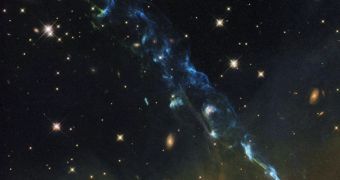An immense geyser of hot gas was recently imaged using the NASA/ESA Hubble Space Telescope. The structure belongs to a class of objects called Herbig-Haro (HH) and its name is HH 110.
As plainly visible, the cosmic formation resembles a large firework going off in space, or the swirls and eddies caused by water flowing over rocks. The gas that forms this structure is produced by a single star, located towards the bottom right side of the image.
The reason why it is so distorted is that it collides with the very dense core of a molecular hydrogen cloud, and then scatters. Plumes of gas separate from the main body of the ejected material, creating this amazing view.
According to astrophysicists, the swirling gases are in excess of a billion times less dense than the smoke that a regular, July 4 firework produces. On the other hand, they are several light-years long.
Scientists say that HH objects are loosely defined, in the sense that they can come in a variation of shapes and sizes. However, their basic configuration is always the same – two jets of heated gas ejected in opposite directions from the surface of a protostar, a stellar object that is not yet fully formed.
The jets themselves are produced by vast amounts of material making their way onto the surface of the protostar, as they contribute to increasing its mass. The object is surrounded by a disk of material from which it feeds, like our Sun was before the planets formed.
This protoplanetary disk can be likened to a fuel tank. In this analogy, the star is the gravitational engine, and the gas jets represent the exhaust fumes, a NASA statement explains. Whenever these exhausts slam into the dense core of the molecular clouds, traffic jams occur.
As the gas at the forefront of the jets is slowed down by the collision, newly released gas backs up behind, creating the rippling effect, and increasing the overall temperatures of these emissions.
What is interesting about HH 110, as opposed to other known Herbig-Haro objects, is that the gas jets are themselves produced by other jets, coming from the nearby structure called HH 270.
“By measuring the current velocity and positions of different blobs and hot ridges along the chain within the jet, astronomers can effectively "rewind" the outflow, extrapolating the blobs back to the moment when they were emitted,” the NASA statement explains.
The data used to compile this composite image were collected by the Advanced Camera for Surveys (ACS) instrument (in 2004 and 2005) and the Wide Field Camera 3 (in April 2011). Both are instruments aboard Hubble.

 14 DAY TRIAL //
14 DAY TRIAL //